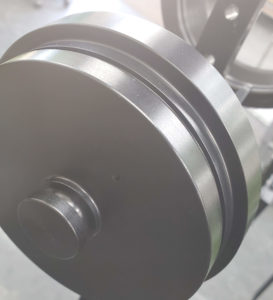Do You Need Precision Hardcoat Anodizing?
Here in the metal finishing world, we see significant confusion among customers regarding anodizing and hardcoat anodizing.

While many of the customers we work with are renowned precision machine shops that are masters of their craft, they understandably don’t know all the ins and outs of metal finishing. Processes like anodizing and hardcoat anodizing involve complex chemistry, and there are many variables to consider.
In some cases, customers overpay for hardcoat anodized aluminum when conventional anodized aluminum would have been sufficient. In other cases, they may opt for standard anodizing when a thicker and harder coating would be optimal for their part.
At Global Metal Finishing, our objective for every project is simple: ensuring you get the exact finish you need
Do you really need hardcoat anodizing, or is conventional anodizing sufficient for your part? Let’s take a closer look.
Anodizing vs. Hardcoat Anodizing
It helps to be on the same page about anodizing and hardcoat anodizing. Here’s a brief definition of each:
Anodizing
Anodizing is an electrochemical process that produces a hard, clear oxide layer (<0.0007” thick) on the surface of a metal part. This hard oxide layer is extremely porous and looks like honeycomb when viewed under a microscope.
To color the metal, dye or ink is deposited or sealed into the pore structure—this sealing process improves corrosion resistance, locks in the color, and stabilizes the surface.
Hardcoat anodizing
Hardcoat anodizing differs from conventional anodizing in that the temperature in the tank is lowered to increase the current density and produce a thicker, more compact oxide layer on the surface of the metal.
This process is ideal for parts that need extra protection under extreme conditions. Unlike conventional anodize, hardcoat anodize is often left unsealed to bond more effectively with paint and preserve its high hardness.
Considerations for Choosing Anodize vs. Hardcoat Anodize
Hardcoat anodizing is more expensive than conventional anodizing. It’s also riskier because it involves hitting the surface of the part with more current, resulting in a higher likelihood of burning. If cost is a priority for you and you don’t actually need hardcoat anodized aluminum, we’ll recommend conventional anodize instead.
How can you make that determination yourself? The primary factors to consider are the part’s environment and intended lifespan.
Will your part be in or around salt water or acid? Hardcoat anodize is your best bet.
Are you looking to protect the part forever? Again, you’ll want to stick with hardcoat anodize.
If the answer to both questions is no, it’s worth a conversation with your metal finisher about whether conventional anodize could be a better choice. You’ll certainly save money if you go in that direction.
We’ve said it before, and we’ll say it again: When in doubt, talk to your metal finishing partner. At Global Metal Finishing, we’re always happy to discuss your part requirements to ensure that you get exactly what you need from us. If you’d like to work with us on your next metal finishing project, request a quote, and we’ll respond within 1 business day.
